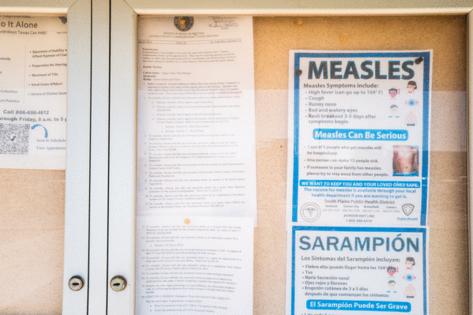New measles exposure reported over July 4th holiday, as cases in Kansas slow
Published in Health & Fitness
The number of new measles cases has slowed in recent weeks in Kansas, reaching 86 confirmed cases, according to the Kansas Department of Health and Environment’s 2025 Kansas Measles Case Data dashboard.
The number of patients infected with measles increased by six over the past two weeks, according to the data updated Monday.
All but three of the cases are associated with the outbreak concentrated in the southwestern part of Kansas. The number of hospitalizations grew to seven, up from three two weeks ago. There have been no deaths connected to the outbreak, health officials said.
Measles cases have been reported in nine counties in that area: Finney, Ford, Grant, Gray, Haskell, Kiowa, Morton, Pawnee and Stevens counties. Health officials report that only Gray. Haskell, Morton, and Stevens counties have an active measles status. A county’s status is active for 42 days following a report of a measles case linked to the outbreak.
The other five counties have a “resolved” status, which indicates more than 42 days have passed with no new cases reported.
Cases have also been reported in Reno and Sedgwick counties, but none of those cases are related to the outbreak.
Majority of cases involved children, teens
Children and teens account for the vast majority of total cases, with 35 involving kids 4 years and younger, 21 involving children between 5 and 10, eight involving children between 11 and 13, and six youths between 14 and 17. The remaining 16 cases include people 18 and older.
The data shows that among those affected by the southwest Kansas outbreak, only seven involved patients who had been vaccinated appropriately. The vast majority of cases, 72, were not vaccinated or not vaccinated appropriately for their age. Four patients were unable to verify their vaccination status.
Gray County, with 28 confirmed cases, has been the hardest hit, followed by Haskell County with 19 cases and Stevens counties with nine cases.
The measles, mumps, and rubella (MMR) vaccine, which has been safely and successfully used for decades, is the most effective way to protect children, health officials said.
Pediatricians are urging families to strongly consider early vaccination to protect their young children if they are hearing about outbreaks nearby.
New measles exposure at Wichita pediatric unit
The health department announced over the Fourth of July holiday weekend that a measles exposure occurred in the Fifth-Floor Pediatric Unit at Wesley Medical Center, located at 550 N. Hillside St. in Wichita.
The exposure occurred from 10 p.m. on July 1 through 4:45 p.m. on July 3, the health officials said in a news release.
Because the measles virus can remain in the air and on surfaces for up to two hours and is highly contagious, anyone who was a patient, staff member, or visitor to the unit during that period may have been exposed.
Health officials said that people who have not been vaccinated, have not had a past measles infection, or have laboratory evidence of immunity, are vulnerable to contracting the disease.
People who were in the pediatric unit should monitor themselves for 21 days after their exposure for symptoms, including a fever and a new or unexplained skin rash. They should contact a healthcare provider or the local health department if symptoms develop, health officials said.
Those who are not immune should consider staying home or avoid large gatherings and contact with others who might be susceptible to prevent the spread of measles, health officials said.
Cases near record since declared eliminated in U.S.
The number of measles cases has surged to a near record high since the disease was declared eliminated in the United States a quarter-century ago.
As of July 1, a total of 1,267 confirmed measles cases have been reported in the United States, according to data from the U.S. Centers for Disease Control and Prevention.
Just halfway through the year, the number of cases is close to surpassing the record set in 2019, when a total of 1,274 confirmed cases were reported. Measles was declared eliminated in the U.S. in 2000. The next closest year with more reported cases is 1992 when 2,126 patients contracted the disease.
Measles has been reported in 37 states — Alaska, Arkansas, Arizona, California, Colorado, Florida, Georgia, Hawaii, Illinois, Indiana, Iowa, Kansas, Kentucky, Louisiana, Maryland, Michigan, Minnesota, Missouri, Montana, Nebraska, New Jersey, New Mexico, New York, North Carolina, North Dakota, Ohio, Oklahoma, Oregon, Pennsylvania, Rhode Island, South Dakota, Tennessee, Texas, Utah, Vermont, Virginia and Washington.
There have been 155 hospitalizations, or 12% of all cases, and three confirmed deaths from measles.
There have been 27 outbreaks this year, with 88%, or 1,115, of confirmed cases being outbreak-associated. In 2024, there were 16 outbreaks, with 69%, or 198 of 285, of all cases being associated with an outbreak.
About 28% of cases involve children under the age of 5, 37% involve patients aged 5 to 19, 34% include adults 20 and older, and 1% involved patients whose age was unknown, according to the CDC.
Approximately 92% of cases involve unvaccinated patients or those with unknown vaccination status. Another 4% involve patients who had received only one dose of MMR vaccine. About 4% patients involved were fully vaccinated.
©2025 The Kansas City Star. Visit at kansascity.com. Distributed by Tribune Content Agency, LLC.










Comments